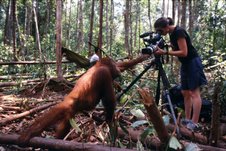Burning Peatland is threatening the Orangutan
Burning Peatland is threatening the Orangutan
BOS Mawas, PRESS RELEASE, Friday 10th November 2006
Pandu B.Wahyono, manager of Mawas Conservation Program of The Borneo Orangutan Survival Foundation (BOS), is overwhelmed by this year’s fire desaster in Mawas. Since the great fires in 1997/8, Kalimantan (the Indonesian part of Borneo) has never experienced such terrible fires again.
BOS Mawas (Mawas means Orangutan) aims to convert approximately 500.000 hectares into a Mawas reservation. This land is situated in Central Kalimantan between the Kapuas and the Barito Rivers. It mainly consists of tropical swamp forest, under which precious CO2-rich peat, and even peat domes thicker then 15 meters, can be found. The Mawas area consists of many different landscapes and ecosystems. Some areas still are virgin swamp forest, home to approx. 3000 wild orangutans. Other forests have been logged for about 20 years and are therefore highly degraded. The worst destruction took place in the western part of Block AB, where a misguided governmental project had been planned. There, the ambitious million hectar ricefield project (Proyek Pengembangan Lahan Gambut, PLG), a project of the Suharto era, allegedly was to raise the economical welfare. Now, this exPLG area is drained, dead and cleared land. Furthermore, it still has major negative impacts on the neighbouring peatlands, because the drains feed on the water, which is stored in the peat like in a sponge.
In Mawas, many peat domes with a thickness up to 20 meters can be found. These peat domes grow very slowly and only under specific conditions. Over 5,000 years organic material has been accumulated under very acidic conditions to form this extraordinary carbon sink, which is highly important as a fresh water supply for the river systems. When these peat domes are logged or planted with oil palms, they dehydrate and collapse. Large amounts of CO2 are emitted because of the drainage. Annually, 600 million tonnes of CO2 are emitted in Indonesia alone by the oxidation of peat. Another 1.5 billion annually emitted CO2 result from forest and peat fires. Normally, the peat is soaked with water, but once the peat is drained, it ignites easily. Peat fires burn underground, they travel unseen beneath the surface and break out in unexpected locations.
Although BOS fire fighters are on duty in Mawas night and day, since yesterday (even supported by fire-fighting plans) large areas of peat forests were burnt. The peat swamp forest of Mawas is home to about 3000 wild orangutan. Only recently, 148 orangutans have been translocated to Blocks AB in Mawas. Now the fires are threatening the unique biodiversity of the peat swamp forest, they put one of the last wild orangutan populations into danger, and they may release the three gigatonnes of carbondioxide which are bound in the peat.
Kisar Odom, representative manager of the BOS Mawas Conservation Program and leader of the research and development team, is constantly monitoring the orangutans. “Several orangutans have tried to escape the fires, others have already crossed the Mantangai River to an area that is regarded to be safer. We are constantly monitoring the situation and, thankfully, have not yet found one dead orangutan.” Ironically, now, while observations are badly needed to monitor the situation of the threatened orangutan population, Kisar Odom and his team have difficulties observing the animals because of the thick smoke.
Three orangutans had to be saved from fires and translocated to a safer forest. Those orangutans had not long ago been introduced to a forest in Block AB which was regarded as safe. But during the last months, 17.815 hectares or 17 % of this forest has been destroyed by fire.
“Fleeing from fires or wandering around in search for food, orangutans often enter oil palm plantations and eat palm seedlings. Farmers, defending their harvest, often hit or kill the animals.” Willie Smits, the founder of the BOS Foundation, further explains that “10-15 orangutans recently died as a result of their injuries. Currently, 120 orangutans are treated in three rehabilitation centres, suffering of dehydration, acute breathing diseases, and starvings and even from wounds.”
Last month, more than 30 Orangutans had to be rescued. They were either driven out of their forest by fires, or they were desperately looking for food in plantations, because their habitat has been destroyed by oil palm plantation companies.
“At the moment we are putting a lot of energy in law enforcement. We hope that offenders and involved parties will be prosecuted. We are supporting the government’s efforts in taking action against plantation companies that are suspected of burning the forest to establish new plantations.” Hardi Baktiantoro, assistant manager of the BOS orangutan reintroduction centre Nyaru Menteng, says. Additionally to law enforcement, BOS conducts community development and education programs in Central and East Kalimantan, with the aim to prevent land clearing, illegal logging, animal abuse and forest fires.
Ironically, more and more oil palms are planted to produce “biofuel”. In Indonesia one quarter of all oil palm plantations are grown on peat land. According to several environmental organisations the establishment of oil palm plantations is not only responsible for a great loss of animal lives and biodiversity, but also for immense emissions of carbondioxide. Data from Wetlands International show that 1 tonne palm oil grown on peat land results in the release of about 20 tonnes of CO2.
Thus, the so called “biofuel” is rather responsible for unrecoverable destruction of unique biodiversity and for irretrievable release of green house gases from ancient carbon sinks than to be the renewable sustainable energy source we are searching for.
By Rita Sastrawan
BOS International
rita@orangutan.or.id
BOS Mawas, PRESS RELEASE, Friday 10th November 2006
Pandu B.Wahyono, manager of Mawas Conservation Program of The Borneo Orangutan Survival Foundation (BOS), is overwhelmed by this year’s fire desaster in Mawas. Since the great fires in 1997/8, Kalimantan (the Indonesian part of Borneo) has never experienced such terrible fires again.
BOS Mawas (Mawas means Orangutan) aims to convert approximately 500.000 hectares into a Mawas reservation. This land is situated in Central Kalimantan between the Kapuas and the Barito Rivers. It mainly consists of tropical swamp forest, under which precious CO2-rich peat, and even peat domes thicker then 15 meters, can be found. The Mawas area consists of many different landscapes and ecosystems. Some areas still are virgin swamp forest, home to approx. 3000 wild orangutans. Other forests have been logged for about 20 years and are therefore highly degraded. The worst destruction took place in the western part of Block AB, where a misguided governmental project had been planned. There, the ambitious million hectar ricefield project (Proyek Pengembangan Lahan Gambut, PLG), a project of the Suharto era, allegedly was to raise the economical welfare. Now, this exPLG area is drained, dead and cleared land. Furthermore, it still has major negative impacts on the neighbouring peatlands, because the drains feed on the water, which is stored in the peat like in a sponge.
In Mawas, many peat domes with a thickness up to 20 meters can be found. These peat domes grow very slowly and only under specific conditions. Over 5,000 years organic material has been accumulated under very acidic conditions to form this extraordinary carbon sink, which is highly important as a fresh water supply for the river systems. When these peat domes are logged or planted with oil palms, they dehydrate and collapse. Large amounts of CO2 are emitted because of the drainage. Annually, 600 million tonnes of CO2 are emitted in Indonesia alone by the oxidation of peat. Another 1.5 billion annually emitted CO2 result from forest and peat fires. Normally, the peat is soaked with water, but once the peat is drained, it ignites easily. Peat fires burn underground, they travel unseen beneath the surface and break out in unexpected locations.
Although BOS fire fighters are on duty in Mawas night and day, since yesterday (even supported by fire-fighting plans) large areas of peat forests were burnt. The peat swamp forest of Mawas is home to about 3000 wild orangutan. Only recently, 148 orangutans have been translocated to Blocks AB in Mawas. Now the fires are threatening the unique biodiversity of the peat swamp forest, they put one of the last wild orangutan populations into danger, and they may release the three gigatonnes of carbondioxide which are bound in the peat.
Kisar Odom, representative manager of the BOS Mawas Conservation Program and leader of the research and development team, is constantly monitoring the orangutans. “Several orangutans have tried to escape the fires, others have already crossed the Mantangai River to an area that is regarded to be safer. We are constantly monitoring the situation and, thankfully, have not yet found one dead orangutan.” Ironically, now, while observations are badly needed to monitor the situation of the threatened orangutan population, Kisar Odom and his team have difficulties observing the animals because of the thick smoke.
Three orangutans had to be saved from fires and translocated to a safer forest. Those orangutans had not long ago been introduced to a forest in Block AB which was regarded as safe. But during the last months, 17.815 hectares or 17 % of this forest has been destroyed by fire.
“Fleeing from fires or wandering around in search for food, orangutans often enter oil palm plantations and eat palm seedlings. Farmers, defending their harvest, often hit or kill the animals.” Willie Smits, the founder of the BOS Foundation, further explains that “10-15 orangutans recently died as a result of their injuries. Currently, 120 orangutans are treated in three rehabilitation centres, suffering of dehydration, acute breathing diseases, and starvings and even from wounds.”
Last month, more than 30 Orangutans had to be rescued. They were either driven out of their forest by fires, or they were desperately looking for food in plantations, because their habitat has been destroyed by oil palm plantation companies.
“At the moment we are putting a lot of energy in law enforcement. We hope that offenders and involved parties will be prosecuted. We are supporting the government’s efforts in taking action against plantation companies that are suspected of burning the forest to establish new plantations.” Hardi Baktiantoro, assistant manager of the BOS orangutan reintroduction centre Nyaru Menteng, says. Additionally to law enforcement, BOS conducts community development and education programs in Central and East Kalimantan, with the aim to prevent land clearing, illegal logging, animal abuse and forest fires.
Ironically, more and more oil palms are planted to produce “biofuel”. In Indonesia one quarter of all oil palm plantations are grown on peat land. According to several environmental organisations the establishment of oil palm plantations is not only responsible for a great loss of animal lives and biodiversity, but also for immense emissions of carbondioxide. Data from Wetlands International show that 1 tonne palm oil grown on peat land results in the release of about 20 tonnes of CO2.
Thus, the so called “biofuel” is rather responsible for unrecoverable destruction of unique biodiversity and for irretrievable release of green house gases from ancient carbon sinks than to be the renewable sustainable energy source we are searching for.
By Rita Sastrawan
BOS International
rita@orangutan.or.id





